Related Research Articles

Food preservation includes processes that make food more resistant to microorganism growth and slow the oxidation of fats. This slows down the decomposition and rancidification process. Food preservation may also include processes that inhibit visual deterioration, such as the enzymatic browning reaction in apples after they are cut during food preparation. By preserving food, food waste can be reduced, which is an important way to decrease production costs and increase the efficiency of food systems, improve food security and nutrition and contribute towards environmental sustainability. For instance, it can reduce the environmental impact of food production.

In botany, a fruit is the seed-bearing structure in flowering plants (angiosperms) that is formed from the ovary after flowering.

Washing is a method of cleaning, usually with water and soap or detergent. Regularly washing and then rinsing both body and clothing is an essential part of good hygiene and health.

Blanching is a cooking process in which a food, usually a vegetable or fruit, is scalded in boiling water, removed after a brief timed interval, and finally plunged into iced water or placed under cold running water to halt the cooking process. Blanching foods helps reduce quality loss over time. Blanching is often used as a treatment prior to freezing, dehydrating, or canning vegetables or fruits to deactivate enzymes, modify texture, remove the peel and wilt tissue. The inactivation of enzymes preserves colour, flavour, and nutritional value. The process has three stages: preheating, blanching, and cooling. The most common blanching methods for vegetables/fruits are hot water and steam, while cooling is either done using cold water or cool air. Other benefits of blanching include removing pesticide residues and decreasing microbial load. Drawbacks to the blanching process can include leaching of water-soluble and heat-sensitive nutrients and the production of effluent.
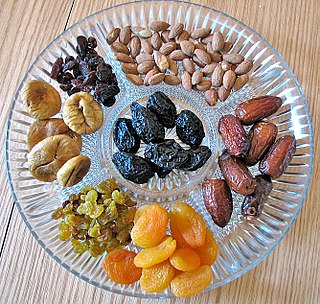
Dried fruit is fruit from which the majority of the original water content has been removed prior to cooking or being eaten on its own. either naturally, Drying may occur by sun, through the use of industrial dehydrators, or by freeze drying. Dried fruit has a long tradition of use dating to the fourth millennium BC in Mesopotamia, and is valued for its sweet taste, nutritional content, and long shelf life.

Baby food is any soft, easily consumed food other than breastmilk or infant formula that is made specifically for human babies between six months and two years old. The food comes in many varieties and flavors that are purchased ready-made from producers, or it may be table food eaten by the family that has been mashed or otherwise broken down.

Green beans are young, unripe fruits of various cultivars of the common bean, although immature or young pods of the runner bean, yardlong bean, and hyacinth bean are used in a similar way. Green beans are known by many common names, including French beans, string beans, and snap beans or simply "snaps." In the Philippines, they are also known as "Baguio beans" or "habichuelas" to distinguish them from yardlong beans.

Pickling is the process of preserving or extending the shelf life of food by either anaerobic fermentation in brine or immersion in vinegar. The pickling procedure typically affects the food's texture and flavor. The resulting food is called a pickle, or, if named, the name is prefaced with the word "pickled". Foods that are pickled include vegetables, fruits, mushrooms, meats, fish, dairy and eggs.

Hair care or haircare is an overall term for hygiene and cosmetology involving the hair which grows from the human scalp, and to a lesser extent facial, pubic and other body hair. Hair care routines differ according to an individual's culture and the physical characteristics of one's hair. Hair may be colored, trimmed, shaved, plucked or otherwise removed with treatments such as waxing, sugaring and threading. Hair care services are offered in salons, barbershops and day spas, and products are available commercially for home use. Laser hair removal and electrolysis are also available, though these are provided by licensed professionals in medical offices or speciality spas.
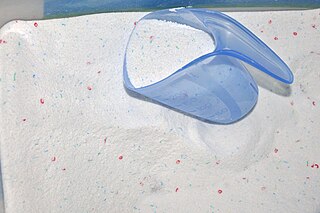
Laundry detergent is a type of detergent used for cleaning dirty laundry (clothes). Laundry detergent is manufactured in powder and liquid form.
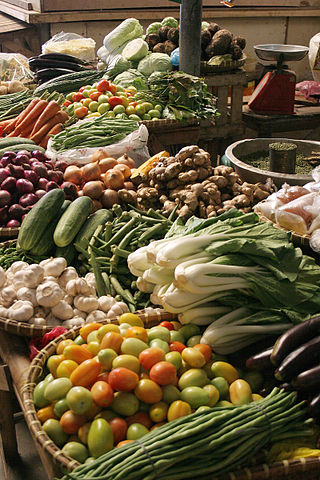
Vegetables are parts of plants that are consumed by humans or other animals as food. The original meaning is still commonly used and is applied to plants collectively to refer to all edible plant matter, including the flowers, fruits, stems, leaves, roots, and seeds. An alternative definition of the term is applied somewhat arbitrarily, often by culinary and cultural tradition. It may exclude foods derived from some plants that are fruits, flowers, nuts, and cereal grains, but include savoury fruits such as tomatoes and courgettes, flowers such as broccoli, and seeds such as pulses.

Fruit preserves are preparations of fruits whose main preserving agent is sugar and sometimes acid, often stored in glass jars and used as a condiment or spread.

Preserved lemon or lemon pickle is a condiment that is common in the cuisines of Indian subcontinent and Morocco. It was also found in 18th-century English cuisine.
Home-stored product entomology is the study of insects that infest foodstuffs stored in the home. It deals with the prevention, detection and eradication of pests.

Home canning or bottling, also known colloquially as putting up or processing, is the process of preserving foods, in particular, fruits, vegetables, and meats, by packing them into glass jars and then heating the jars to create a vacuum seal and kill the organisms that would create spoilage.

Juice is a drink made from the extraction or pressing of the natural liquid contained in fruit and vegetables. It can also refer to liquids that are flavored with concentrate or other biological food sources, such as meat or seafood, such as clam juice. Juice is commonly consumed as a beverage or used as an ingredient or flavoring in foods or other beverages, such as smoothies. Juice emerged as a popular beverage choice after the development of pasteurization methods enabled its preservation without using fermentation. The largest fruit juice consumers are New Zealand and Colombia. Fruit juice consumption on average increases with a country's income level.
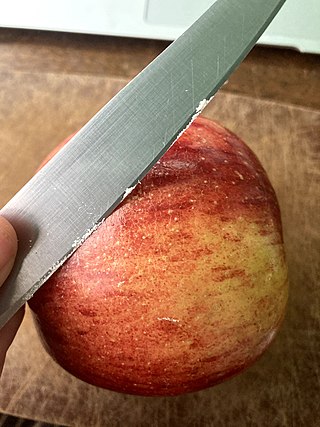
Fruit waxing is the process of covering fruits with artificial waxing material. Natural wax is removed first, usually by washing, followed by a coating of a biological or petroleum derived wax. Potentially allergenic proteins may be combined with shellac.

The Celebrity tomato cultivar is a hybrid (biology) that produces long fruit-bearing stems holding 20 or more very plump, robust tomatoes. Fruits weigh approximately 8 oz., and are 4 inches across. Plants need caging or staking, and produce fruit throughout the growing season. The celebrity tomato is a cultivar of the species Solanum lycopersicum. It is a crossbreed of the common tomato that is widely used for various culinary purposes. This tomato is of great size and is known to be resistant to most tomato diseases such as Fusarium wilt, Verticillium wilt, Tobacco mosaic virus and Root-knot nematode due to its hybrid nature. Celebrity tomatoes are highly adaptive to harsh environments and can grow in a wide range of places including dry, humid and wet regions. They are resistant to cracking and splitting which usually occurs when there is an excess of water and sugar movement in the fruits. Therefore, causing the tomato skin to grow at a slower rate compared to the expansion of the fruit. They can survive in harsh uneven rainfall. However, they are highly susceptible to colder environments and are at a higher risk of dying in regions with short growing seasons. The plants can grow up to 5 feet in height with bright red medium-sized fruits. The plants are generally very thick and grow in clusters. The tomato fruits are mostly used in the making of various salsas, salads, juices and canned food.
Korean natural farming (KNF) is an organic agricultural method that takes advantage of indigenous microorganisms (IMO) to produce rich soil that yields high output without the use of herbicides or pesticides.
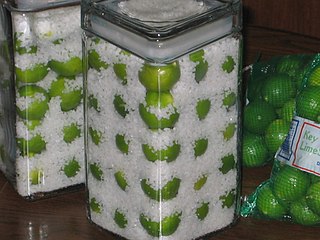
Pickled fruit refers to fruit that has been pickled. Pickling is the process of food preservation by either anaerobic fermentation in brine or immersion in vinegar. Many types of fruit are pickled. Some examples include peaches, apples, crabapples, pears, plums, grapes, currants, tomatoes and olives. Vinegar may also be prepared from fruit, such as apple cider vinegar.
References
- ↑ "Is Your Kitchen Stocked With Sumabrite Veg & Fruit Wash? - Diversey". 18 November 2021. Retrieved 2022-02-18.
- 1 2 3 Gerald M. Sapers; Ethan B. Solomon; Karl R. Matthews (28 May 2009). The Produce Contamination Problem: Causes and Solutions . Academic Press. pp. 405–406. ISBN 978-0-12-374186-8.
- 1 2 3 Gerald M. Sapers; James R. Gorny; Ahmed Elmeleigy Yousef (29 August 2005). Microbiology Of Fruits And Vegetables. CRC Press. p. 393. ISBN 978-0-8493-2261-7.
- ↑ Zander, A. "Washing Fruits and Vegetables." Colorado State University Cooperative Extension, Boulder County. June 30, 2000. http://www.ext.colostate.edu/pubs/foodnut/09380.html [ dead link ]